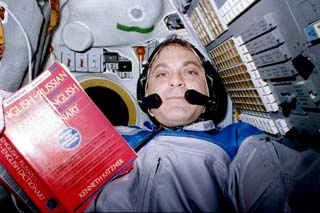


Language differences were some of the biggest challenges for Shuttle-Mir Program team members. Many NASA team members took Russian classes, and NASA's Mir astronauts had to learn Russian to fly aboard Mir. However, they did not have time to learn Russian as well as most other non-Russian Mir crew members.
For English speakers, Russian is often more difficult to learn than western European languages. It words have Slavic roots - rather than Germanic or Latin - so it sounds unfamiliar to a native English speaker. A sentence's word order can vary, depending on context. Further, Russian is written using the Cyrillic alphabet, which has 33 letters and is more similar to the Greek alphabet than to the Roman alphabet used in English.
Russian speakers had similar problems learning and speaking English. Therefore, in the scope of the Shuttle-Mir Program, it was not possible to use to a single-language operation. Yet in the interest of safety and effective operation, it was crucial that both sides have a clear understanding of all procedures and plans. As a result, a method was developed to present all detailed joint procedures in both languages. Identical steps in each language were printed on facing pages of checklists.
Language, of course, is also a big part of cultural and social interactions between American and Russian team members, both on Mir and on the ground.
Related
Links:
Foale
on Language
Lucid on Language
Cultural Background
Meanings of
Mir
![]()
|
|
Curator:
Kim Dismukes
Responsible NASA Official: John Ira Petty |
.gif)